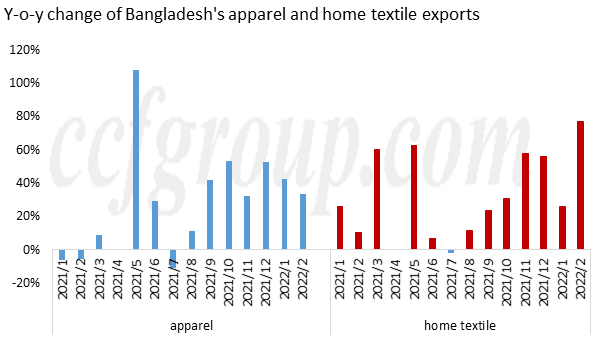Bangladesh's apparel and home textile exports in Jan-Feb maintained rapid growth
With the recovery of textile and apparel demand from Europe and the United States, Bangladesh's apparel exports have soared since last year. The exports in 2021 reached 35.8 billion USD, up 30.4% year-on-year and 8.3% from 2019 before the pandemic. Europe and the United States were the main export markets of Bangladesh's apparel, Europe accounting for 60% and the 20% to the United States. Especially, Bangladesh's apparel exports to the United States grew rapidly last year. The latest data showed that Bangladesh's apparel exports in Jan-Feb 2022 were 7.6 billion USD, up 38.4% from the same period last year, of which woven apparel exports were 3.69 billion USD, up 38% from the same period last year and knitted ones were 3.91 billion USD, up 38.8% year-on-year.
Bangladesh's home textile exports in 2021 were 1.3 billion USD, up 39% over the previous year and 60% over 2019 before the pandemic, indicating the rapid development of Bangladesh's home textile industry in recent years. The latest data show that Bangladesh's home textile exports in Jan-Feb 2022 were 278 million USD, up 51.5% over the same period last year. Bangladesh's apparel and home textile exports have maintained rapid growth since September last year, with a year-on-year growth rate of more than 30%, while home textiles have also maintained high growth.

Y-o-y growth of Bangladesh's apparel exports declined for two months in a row, but remained at a high level, and that of home textile exports reached a new high again (except in April 2021 when the severe pandemic resulted in the high growth, deviating from normal value).
![80O6}HUC(0Q]JV~B)JNO(IP.png 80O6}HUC(0Q]JV~B)JNO(IP.png](https://pic.ccf.com.cn/2022/03/20220311011135320.png)
In conclusion, the growth of Bangladesh's apparel and home textile exports was mainly due to the recovery of consumption in Europe and the United States. After the recovery last year, the growth rate may slow down this year in the context of geopolitics and Fed interest rate hikes. However, Europe and the United States have announced the gradual relaxation of anti-pandemic measures, so production and consumption gradually return to normal levels, and there is still a certain demand recovery in the short term.
From the price trend of textile feedstock and semi-finished products in the midstream and upstream this year, we can see that market orders have weakened. It is well known that Bangladesh is the world’s second-largest clothing exporter-behind only China, its textile feedstock and semi-finished products are in short supply, highly dependent on imports, while India and China are its main sources. Take cotton yarn as an example. Bangladesh’s cotton yarn is mainly imported from India, so did China. Last year, the price of Indian cotton yarn continued to rise, and procurement from China gradually decreased, and Chinese buyers came to be less accepting of the prices than the buyers from Bangladesh. According to Indian manufacturers, the tolerable price in Bangladesh was more than 15cents/kg higher than that in China. However, there were defaults and buyers were obliged to cover feedstock and semi-finished products at higher price levels, which was also one of the reasons for the recent sluggish sales and falling prices of Indian cotton yarn. It is expected that the growth rate of Bangladesh's apparel exports may gradually decline in the second quarter.
- Top keywords
- Cotton Price
- Cotton Futures Price
- Cotton Futures
- CZCE
- PTA Futures Price
- Chemical Fiber
- Polyester Prices
- Wool price
- PTA Futures
- Shengze Silk
- China
- Yarn Price
- price
- China Textile City
- Fibre Price
- Benzene Price
- Cotton
- Index
- Cotton Index
- PTA
- fabric price
- NYMEX
- Top 10
- textile industry
- Spot Cotton
- Cotton Yarn
- Polyester Price
- Futures
- PTA Price
- cotton yarn price

